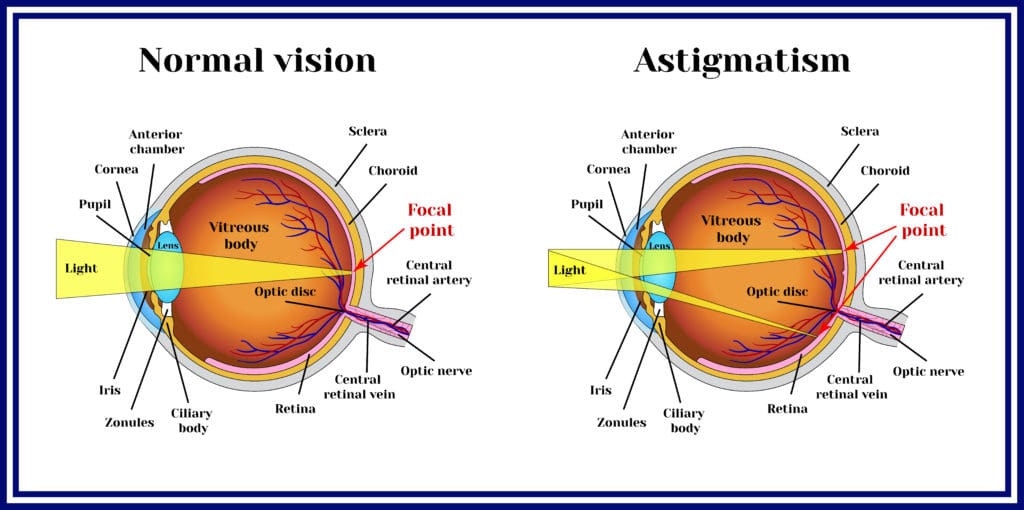The Best Contact Lenses: How to Choose
Home / Understanding Contacts /
Last Updated:
Contact lenses offer some exciting options for people with vision problems. They are effective, almost invisible tools that correct refractive errors and other vision problems you may have. Thanks to their technological enhancements, you can now choose from a variety of contact lens options.
Table of Contents
Types of Contact Lenses
- Gas-permeable contact lenses are best for those who want crisp, sharp vision and are willing to perform the maintenance these lenses require. Optimum contact lenses are among the favorites in this category.
- Daily wear contact lenses are the least expensive option on the list. You have to take them out and disinfect them. In addition, you also have to replace them regularly, depending on the type and brand of daily wear lenses you are using.
- Extended wear contact lenses are designed in such a way that you can wear them for longer durations (even overnight). But you will need to remove them at least once a week to allow your eyes to rest and to clean and disinfect the lenses.
- Other types of disposable lenses work in the same way, but they can be worn longer. In both of these disposable categories, we like the Acuvue models.
- Bifocal lenses are good for those with presbyopia, and we like the SofLens product.
- Monovision lenses will not have the same lens prescription for both eyes. One eye will have a contact for seeing up close, while the other eye will have a contact for distance vision. It takes a while to get used to this setting.
- Toric lenses are meant for those with astigmatism, and we prefer the Optima toric product.
Clearly, there are many types of contacts to choose from. Your doctor might encourage you to move to daily disposable lenses, as these come with the highest safety profile. But there are questions you can ask yourself as you determine what type of contact might be best for you.
You deserve clear vision. We can help.
With 135+ locations and over 2.5 million procedures performed, our board-certified eye surgeons deliver results you can trust.
Your journey to better vision starts here.
Gas-Permeable Contact Lenses
Gas-permeable contact lenses are made of a stiff but permeable material. It allows oxygen to connect with the surface of the eye. According to the Contact Lens Manufacturers Association, this form of lens does not contain water, and that means it is less likely than soft contact lenses to harbor and encourage the growth of bacteria. These lenses also last longer than traditional soft contact lenses.

In addition, this lens requires regular cleaning every night, and it shouldn’t be slept in. Those who cannot abide by those rules might not enjoy life with this lens.
There are many lenses in this category, including the Optimum from Contamac. This form of lens, according to the manufacturer, comes with a high degree of oxygen permeability, making it a good choice for comfort. It also comes in a wide range of strengths and attributes, so it could be a solid option for a variety of vision correction needs. The surface of the lens also stays wet, which enhances comfort.
Rigid Gas Permeable Lenses
Rigid gas-permeable (RGP) lenses are made from silicone and are designed to allow oxygen to pass through them and into your cornea. This way, they do not hinder the amount of oxygen that reaches your cornea.
RGP lenses can correct substantial astigmatism and are easy to care for and maintain. They are also more durable than soft lenses.
Daily Disposable Lenses
This form of lens, as the name implies, is meant to be thrown away at the end of each day. People who choose this particular form of lens do not need to invest in contact cases, cleaning solution, rewetting drops, or other maintenance tools. They can simply pop in a new lens each day.

Daily disposable lenses come with a smaller risk of infection, as they do not stay in contact with the surface of the eye for days or weeks at a time. But they can be expensive for consumers, as a new pair needs to pop into the eye each day. Consumers on a budget might balk at this idea even if they are told that this lens comes with a smaller risk of eye infection.
Among the daily disposables available, the Acuvue Moist is a good option. This lens comes with added wetting features, according to the manufacturer, which can make the lens more comfortable to wear. Those who struggle with traditional contacts, as they seem drying or irritating, might appreciate these features.
You deserve clear vision. We can help.
With 135+ locations and over 2.5 million procedures performed, our board-certified eye surgeons deliver results you can trust.
Your journey to better vision starts here.
Other Forms of Disposable Lenses
Replacing a lens each day can be a burden for some people, but they may still want the infection protection that comes with a disposable lens. There are other extended wear options available, including lenses that can be replaced weekly, every other week, and monthly.
These lenses do require patient compliance, as you will need to wash your hands and disinfect the lenses. Often, you will need to disinfect those lenses daily, and you might not have lenses that are safe for you to wear while you sleep through the night or nap during the day. Consumers who know they will not keep up with this routine may not appreciate these lenses.
Among this category of lenses, we like the Acuvue Vita. According to the manufacturer, this form of lens is designed to be worn for a month before replacement, and each lens comes with a special technology that enhances the sensation of wetness. That can lead to added comfort, especially for those with dry eyes or other sensitivities.
Bifocal Contact Lenses
The lenses in your eyes gradually lose their ability to focus on objects from far to near as you age. This condition is called presbyopia, or farsightedness. You also find it difficult to read words up close.
Bifocal lenses can help if you are having trouble with near and far vision. Bifocal lenses have both the near prescription and distance prescription in one lens. You will need a professional to examine you and fit you with the best bifocal lens design.
Multifocal Contact Lenses
Traditional contact lenses are made to correct just one type of vision issue. If you struggle to see things far from your eyes, your traditional contact lenses boost your distance vision, so those objects come into sharp focus. If you can’t see things close to you, traditional contacts make those close items become clear.
But that can lead to the need for glasses on top of contacts. For example, if your distance vision is corrected but you struggle with age-related close vision loss, you may need glasses in addition to contacts in order to read or knit.
Multifocal contact lenses, according to Cooper Vision, are made to provide a gradual transition between a prescription for nearsightedness and a prescription for farsightedness. There are zones within the contacts that are ideal for each vision type, and in time, the brain learns to map those zones, so you can always see clearly.
The SofLens product from Bausch and Lomb provides this kind of vision correction. This lens offers broad transitions, so they are easy to adjust to for most people. They are made to be replaced every two weeks, so they offer infection control.
Toric Contact Lenses
People with astigmatism have an unusual eye shape, and that shape can lead to blurred vision at all distances. Whether they are looking at things near or far, people with astigmatism may feel as though they just can’t quite pull things into focus. Toric lenses are designed to fit that unusual eye shape, providing clear correction even after blinks and eye movement.

Finding the proper contact lens fit is important here, as a lens that is not quite the right shape will not provide the level of correction needed to deliver clear vision. Some people need to experiment with different manufacturers in order to find a lens that works for their specific eye shape.
The Optima lens from Bausch and Lomb is one such lens people might try. It’s a traditional lens, as the manufacturer points out, as it has been prescribed for more than 30 years. But this contact lens delivers crisp vision for many people with astigmatism.
How to Choose Contacts
There are many different types of contacts to choose from, and each lens type has many manufacturers and brands within it. That means consumers have dozens of different types of lenses to choose from. Doctors can help their patients to make the right choice.
In an article published in Review of Optometry, experts report that daily use soft lenses are the clear choice for many eye doctors due to their lowered risk of eye infection. But doctors also know that some patients are resistant to the idea of throwing away a lens each day. Your doctor may continue to explain why these lenses are a good fit for you, and after that conversation, you might be convinced to give this lens type a try.
The American Optometric Association also recommends considering how much daily contact maintenance you are really willing to do. If you know, right away, that you will not be able to maintain a daily cleansing schedule, choosing contacts that require this help will leave you feeling unhappy and your eyes might be unhealthy too.
You deserve clear vision. We can help.
With 135+ locations and over 2.5 million procedures performed, our board-certified eye surgeons deliver results you can trust.
Your journey to better vision starts here.
References
- Making Better Contact Lenses. (March 2017). Chemical and Engineering News.
- Contact Lens Manufacturers Look to the Future. (September 2018). Primary Care Optometry News.
- Contact Lens Manufacturing Industry in the U.S. (October 2017). IBIS World.
- About Contact Lenses. Contact Lens Manufacturers Association.
- Optimum. Contamac.
- 1-Day Acuvue Moist. Johnson and Johnson Vision.
- Acuvue Vita Monthly Contact Lenses. Acuvue Brand Contact Lenses.
- Multifocal Contact Lenses. Cooper Vision.
- SofLens Multi-Focal Contact Lenses. Bausch and Lomb.
- Optima Toric Contact Lenses. Bausch and Lomb.
- Choosing the Right Contact Lens Modality. (August 2017). Review of Optometry.
- Contact Considerations: Choosing the Right Lens. (March 2017). American Optometric Association.
- Presbyopia. (February 25, 2020). Harvard Medical School.
- Coronavirus.(July 2021). World Health Organization.
- Astigmatism. (June 26, 2019). National Eye Institute.
- Contact Lenses for Vision Correction. (March 4, 2021). American Academy of Ophthalmology.
This content is for informational purposes only. It may have been reviewed by a licensed physician, but is not intended to serve as a substitute for professional medical advice. Always consult your healthcare provider with any health concerns. For more, read our Privacy Policy and Editorial Policy.
